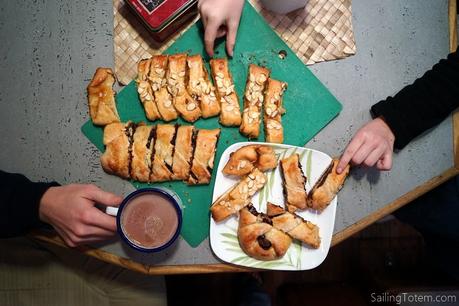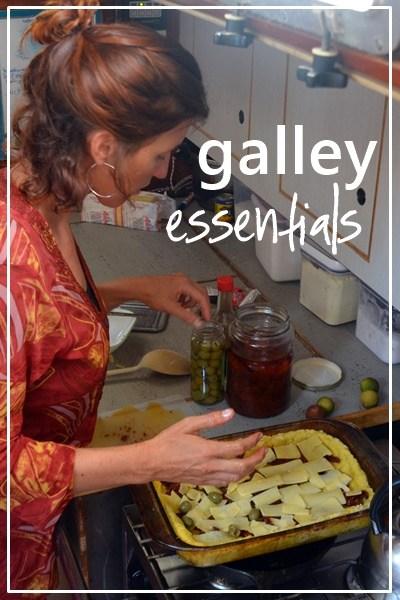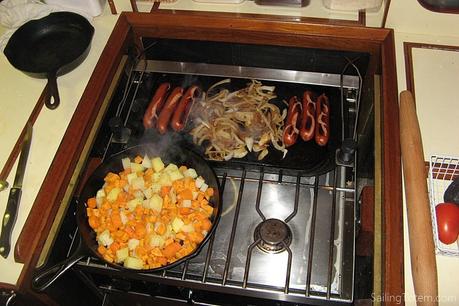

Returning to Totem recently provided fresh perspective on land kitchens vs boat galleys. Last night, as our dinner cooked in the oven, Jamie and I wondered to each other that it seemed to be taking a long time. Then we remembered we were trying to compare a little boat oven with the beast of a Wolf convection oven at my parent’s home. Right, that’s what’s different!
Jamie and I love to cook: it’s fun, it’s relaxing, it’s a way to share time with friends, it’s a way to get to know the cultures we travel through as we experiment with new ingredients and flavors. My last cooking aboard post was about transitioning land kitchen functionality to a boat, without the power gadgets and space hogs. This highlights what we use most on board, to help inform a minimalist galley setup.
Everyday basics
- Knives. 99% of our needs are met between a chef’s knife, a bread knife and a filet knife. A heavy-duty cleaver doubles for a machete to crack coconuts. I don’t think you need anything more! Don’t forget a sharpener, and remember that just like on land, quality knives are worth the investment. Most of ours are the well-made Wusthof knives received as wedding gifts more than 23 years ago.
- Cutting board. We use thin flexible plastic boards. They are lightweight, compact, and double up for use by folding easily into a funnel (most often used for funneling water from a jerry can into Totem’s tanks). We are ALWAYS looking for multiple-use functionality!
- Durable measuring cups and spoons. I thought silicon measuring cups were convenient. These collapsible cups would wear out after a couple of years, tearing along flex points: very inconvenient! Replaced five years ago with heavy duty stainless cups like these, carried to Borneo in a friend’s duffle, basically indestructible.
- Mixing bowls– Our mixing/serving bowls are melamine. Nesting bowls make the best use of space; we currently have these Oxo bowls, and previously a set from Williams Sonoma. Eventually, melamine becomes brittle and fractures. Nonskid bottoms and pouring spouts are handy.
On the Stove
- Tea kettle. Ours lives on the stovetop. Seek out quality stainless, so it doesn’t rust out, and a secure lid. It’s not necessary to pay the marine markup for a chandlery kettle.
- Nesting cookware. We’ve had a four-pot set by Fagor / Rapid Chef (this set at Galleyware) for over a decade. It’s no longer on the market, but this set from Magma is very similar and it (or the 10-piece set) and would be my pick for new pots. Our set is four pots, plus lids, plus two handles. We did not keep the plastic lids and an additional skillet (nonstick) didn’t last long.
- Pressure cooker. People either love them, or they’re indifferent. I’m in the former category. Ours is a 6 quart Kuhn Rikon model similar to the 8L one in this listing (they don’t make our model any more). It’s fantastic, but the much less expensive Fagor pressure cooker gets raves reviews and is an excellent value.
- Cast iron skillet. Yes, you can bring cast iron onto a boat. More dinners are cooked in our cast iron than any other single pot/skillet/etc.: the 11”, high-side skillet is a galley workhorse. Keep it oiled on all sides to avoid rusting.

In the Oven
We don’t use an oven as much use as it did at home, because boat ovens aren’t insulated and who needs to add MORE heat to a boat in the tropics? (That’s one reason why I adore my Solavore solar oven!) But we do use it sometimes, and right now, it’s actually helping us GET warm. Turns out the Sonora desert in cold in November – we did not get that disclaimer.
- Pyrex pans: A single 9×13 (3 quart) pan meets our needs for family-size casseroles and cakes. For a couple, the 2-quart size is probably plenty and easier to store.
- Bundt pan: If you’re a baker, consider that boat ovens usually are too small to fit two round pans for a layer cake. Bonus: the tube shape takes less cooking time, which means less oven time / less propane. Alternatively, use a muffin tin for quick breads and cupcakes. That cooks even faster for less propane used/ heat. Silicone sounds good, but it’s not sturdy enough; we have reusable silicone muffin tin liners.
- Cookie sheet: we have a single cookie sheet that does double duty as a stove-top griddle for toasted sandwiches or the current favorite, quesadillas. A silicone baking mat (I love Silpat mats!) helps keep things clean and lets me rotate it through more dishes.
Galley favorites
These are items I might have had at home, but overlooked, where on the boat they get a lot of use. Some made it into my kitchen-to-galley transition post for that reason!
- Citrus press. Here in Mexico, there are a lot of limones to make limonada from! Also: margaritas. Get a good one, not cheap junk.
- A small scale, to weigh and also—importantly!—to convert weights between imperial and metric, since most of the world is metric. Ours looks a lot like this; this makes recipe conversions easier for me.
- Yogurt maker. I used to just buy yogurt; on board I make it. I used to think foofy makers like our Easiyo (basically, a big thermos) were unnecessary and I would make my own yogurt just fine on the stove. Which I could. But then I inherited this beauty from a cruiser retiring to land and it makes yogurt foolproof.
- Cheese grater. OK, so this had a lot of use before, too, but that old box grater is NOT boat-storage-friendly! The key is to get a FLAT grater: we have one like this. Our kids are powered by quesadillas, cheese grater required.
- Mandoline. It makes quick work (and beautifully even slices) of veggies; thin, uniform slices cook more efficiently, and I’m all about less time in a hot galley in the tropics. We currently have an Oxo mandoline.
- Immersion blender. Most of the time it purees soups or makes smoothies, but it’s also great for pureeing up a batch of hummus and when we had a bowl attachment (lost, wah!), it chopped veggies for salsa etc. as well. Highly versatile replacement for multiple kitchen gadgets.

There’s more, of course, that shifts in use over seasons and regions as different dishes pass through our lives. It’s part of the fun of cruising! These are our basics, and where I’d start if we were outfitting a new galley.

